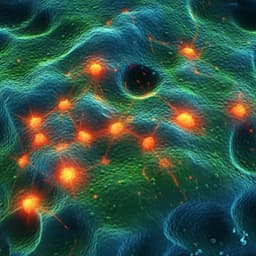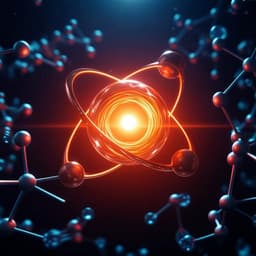
Chemistry
Ten-electron count rule for the binding of adsorbates on single-atom alloy catalysts
J. Schumann, M. Stamatakis, et al.
Discover the groundbreaking findings from Julia Schumann, Michail Stamatakis, Angelos Michaelides, and Romain Réocreux that unveil a 10-electron count rule for adsorbate binding in single-atom alloys! This innovative study simplifies the design of SAA catalysts, promising to accelerate advancements in hydrogenation reactions.
~3 min • Beginner • English
Introduction
The study addresses the lack of a simple, physically transparent framework to predict and design catalytic performance of single-atom alloys (SAAs). While adsorption energies and the d-band model successfully rationalize trends on pure transition metals, SAAs and near-surface alloys often deviate from these linear scaling relationships. Prior high-throughput DFT and machine-learning approaches can predict adsorption energies but offer limited mechanistic insight. The authors propose a paradigm shift: treat SAA active sites as molecular-like centers with discrete, free-atom-like d-states and rationalize adsorbate binding via molecular orbital (MO) theory and electron counting, analogous to rules used in organometallic chemistry. The purpose is to derive a simple electron-count rule that captures periodic trends in adsorbate binding on SAA dopants and to demonstrate its utility for catalyst design, exemplified by nitrogen reduction.
Literature Review
Classical Sabatier-based frameworks link optimal catalysis to intermediate adsorption strengths, often correlated with the metal d-band center. However, for SAAs and related near-surface alloys, adsorption trends can be nonmonotonic and escape simple d-band predictions; NSAs require corrections and stability rules, and SAAs remain inadequately described by these models. Machine learning provides efficient and accurate predictions for adsorption on alloys and SAAs but lacks interpretability and fundamental physical guidance. Recent perspectives liken SAAs to molecular systems with discrete states, motivating the use of MO-based electron-counting rules (e.g., octet, Hückel aromaticity) familiar from organometallic chemistry to rationalize chemisorption.
Methodology
Density functional theory (DFT) calculations were performed with VASP 5.4.4 using the projector-augmented wave (PAW) method. The optB86b-vdW functional was employed for most systems; RPBE was used for CO and NO adsorption. A plane-wave cutoff of 400 eV, electronic convergence of 1e-5 eV, and force convergence below 0.02 eV Å−1 were applied. Surfaces were modeled as five-layer p(3×3) fcc slabs (Cu, Ag, Au hosts), with the bottom two layers fixed at bulk positions; optimized bulk lattice constants were 3.60 Å (Cu), 4.09 Å (Ag), and 4.13 Å (Au). A 15 Å vacuum separated slabs. For adsorption energy screening, a 3×3×1 Monkhorst–Pack k-point mesh was used (validated against 13×13×1 for trends). Adsorbates were initially placed atop the dopant and optimized; overall trends persist for fcc-site adsorption. Adsorption energies (ΔEads) were computed using dipole-corrected slabs referenced to gas-phase atoms. Spin-unrestricted calculations were performed, initialized from spin-restricted charge densities for robust convergence. Electronic structure analyses—projected DOS (PDOS) and crystal orbital Hamilton population (COHP)—were carried out with LOBSTER, using VASP runs with 13×13×1 k-points and ISYM = −1. Bader charges were obtained using VTST tools. MO population analyses were derived by integrating PDOS contributions to bonding, nonbonding, and antibonding states with integration limits defined by COHP sign changes and the Fermi level. Data are available in the NOMAD Repository.
Key Findings
- Discovery of a universal 10-electron count rule for adsorbate binding on SAA dopants: the strongest covalent interaction occurs when the number of valence electrons of the dopant (ν_M, i.e., group number) plus the number of adsorbate electrons that interact with metal d-states (k) equals 10 (ν_M + k = 10). For p-block atoms, apparent 12-electron optima arise if a nonbonding lone pair is counted; excluding this lone pair reveals the universal 10-electron rule.
- Periodic trends: On 4d and 5d dopants, adsorption energies of atomic adsorbates (O, N, C, H) show deep V-shaped trends with minima that shift rightward as the adsorbate’s interacting electron count decreases (O > N > C > H). On 3d dopants, W-shaped trends with a fixed maximum near Mn arise due to spin effects; suppressing spin recovers 4d/5d-like behavior.
- MO rationale validated: MO diagrams for H and p-block adsorbates explain the number and ordering of bonding, nonbonding, and antibonding states. PDOS and COHP analyses for model systems (e.g., H on ZrAg, RhAg; N on ZrAg, RhAg) confirm the expected σ, π, nonbonding n_g/n_u, and antibonding σ*, π* features and their fillings. Binding strengthens until all bonding and nonbonding d-contributing MOs (five orbitals) are filled (10 electrons); further electron addition populates antibonding states and weakens adsorption.
- Extension to molecules: Counting only the electrons that interact with metal d-states (k) predicts optima at d^(10−k). Examples: CO (k=2) binds strongest on d^8; linear NO (k=3) on d^7; these predictions match DFT trends. A table of v_A and k is provided for atomic and molecular adsorbates (e.g., H k=1; C k=2; N k=3; O k=4; H2O, NH3 k=2; CO k=2; N2 k=3; linear NO k=1, bent NO k=2; C2H4 k=1).
- Electrostatics-dominated cases: For H2O and NH3, adsorption trends are dominated by electrostatics, reflected in minimal charge-density rearrangement and adsorption energies correlating with dopant Bader charges (ranging roughly from −0.22e to +1.61e across 4d). Removing electrostatic contributions recovers covalent minima at d^8. Similar caveats apply to halogens and hydroxyl.
- Catalyst design application: For N2 reduction on Au-based SAAs, the first hydrogenation step (N2 → NNH) is endothermic and rate-determining. The rule predicts N2 binds strongest on d^5 (Ru, Os) and NNH (isolobal to NO) on d^6 (Tc, Re). DFT confirms these trends; the reaction energy gap narrows near d^6, identifying Re and Tc as most favorable, with Mo and W (left of d^6) as viable, practical alternatives. This guidance reduces the candidate space by over an order of magnitude, aligning with prior high-throughput and ML findings while offering a mechanistic rationale.
Discussion
The 10-electron count rule provides a simple, physically grounded framework that explains nonmonotonic adsorption trends on SAAs and supersedes the limited applicability of linear d-band scaling in these systems. By focusing on the occupancy of bonding and nonbonding d-derived MOs at the dopant site, the rule rationalizes why strongest binding occurs at ν_M + k = 10 and why 3d dopants deviate due to spin-induced weakening near Mn. The MO-based perspective bridges SAA surface chemistry with organometallic ligand-field concepts, enabling accurate, interpretable predictions for both atomic and molecular adsorbates when covalent interactions dominate. Exceptions—closed-shell, highly polarized adsorbates—are captured by considering dopant charge rather than electron counting. The rule directly informs catalyst selection, as shown for N2 hydrogenation where differing minima for N2 and NNH across 4d/5d dopants identify d^6 centers (Re, Tc) as optimal, with neighboring dopants (Mo, W) offering practical options. This mechanistic clarity aids targeted screening, focusing computational and experimental efforts on the most promising dopants.
Conclusion
This work introduces and validates a universal 10-electron count rule for adsorbate binding at SAA dopant sites, grounded in an MO description corroborated by PDOS and COHP analyses over thousands of DFT calculations. The rule unifies trends for atomic and molecular adsorbates across 4d and 5d dopants and explains deviations for 3d dopants via spin effects. It delineates when electron counting applies (covalent binding) versus when electrostatics governs (e.g., H2O, NH3, halogens, OH), where dopant charge is the better descriptor. Applied to N2 reduction, the framework rapidly pinpoints d^6 dopants (Re, Tc) and practical neighbors (Mo, W) as favorable, dramatically shrinking the search space without heavy computation. Future research should integrate kinetics, solvation and field effects, explore alternative adsorption geometries and sites, extend to broader hosts and alloy environments, and experimentally validate the predicted optima and mechanistic insights.
Limitations
- The 10-electron rule holds when covalent metal–adsorbate interactions dominate; for electrostatics-dominated adsorbates (e.g., H2O, NH3, halogens, OH), dopant charge better predicts trends, reducing the rule’s practical applicability.
- 3d dopants exhibit spin-driven deviations (W-shaped trends with a maximum near Mn), complicating simple electron-count predictions.
- Calculations primarily consider atop adsorption sites and idealized SAA models; other sites/geometries can alter k and binding trends.
- The MO-based counting simplifies host–dopant charge transfer and band effects; while trends are robust, quantitative predictions may require full DFT and kinetic modeling.
- Application to catalysis (e.g., N2 reduction) focuses on a key thermodynamic step; full activity/selectivity demands analysis of kinetics, competing pathways, and environmental effects (solvent, potential, fields).
Related Publications
Explore these studies to deepen your understanding of the subject.







